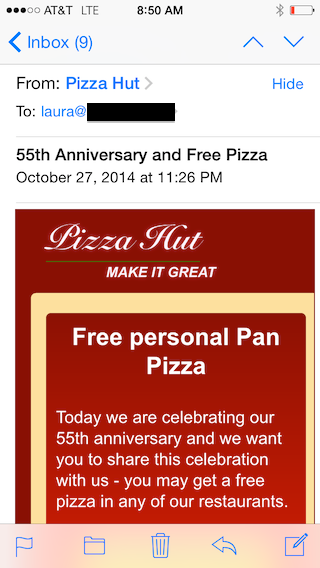Phish
Thinking about filters
Much of the current deliverability advice focuses on a few key ideas:
Read MoreEmail is inherently a malicious traffic stream
It’s something many people don’t think about, but the majority of the traffic coming into the SMTP port is malicious. Spam is passively malicious, in that it just uses resources and bothers people. But there is a lot of actively malicious traffic coming into the SMTP port. Email is used as a vector to spread viruses and other malware. Email is also used for phishing and scamming. Many of the major hacks we’ve heard about over the last few years, including those in the email space, started with a single user getting infected through email.
We talk a lot about delivery here with clients and primarily focus on making sure their mail looks as unlike malicious mail as possible. We focus on spam filters, but every piece of mail goes through filters that also look for viruses, phishes, malware and other malicious traffic.
Mail servers are under attack constantly. The only reason our inboxes are useful is through the hard work of many people to filter out the bad and keep users from seeing the bulk of the mess attacking them.
Spam, Phish or Malware?
Some mornings I check mail from my phone. This showed up this morning.
My first thought was “oh, no, Pizza Hut is spamming, wonder who sold them my address.”
Then I remembered that iOS is horrible and won’t show you anything other than the Friendly From and maybe it was some weird phishing scheme.
When I got to my real mail client I checked headers, and sure enough, it wasn’t really from Pizza Hut. I’m guessing actually malware, but I don’t have a forensics machine to click the link and I’m not doing it on anything I can’t wipe (and have isolated from the rest of my network).
The frustrating thing for me is that this is an authenticated email. It not from Pizza Hut, the address belongs to some company in France. Apparently, that company has had their systems cracked and malware sent through them. Fully authenticated malware, pretending to be Pizza Hut, and passing authentication on various devices.
Pizza Hut isn’t currently publishing a DMARC record, but in this case, a DMARC record for Pizza Hut wouldn’t matter. None of the email addresses in the headers point to Pizza Hut.
I spent last week listening to a lot of people discussing DMARC and authentication and protecting people from scams and headers. But those all the protocols in the world won’t protect against this kind of thing. Phishing and malware can’t be fixed by technology alone. Even if every domain on the planet published a p=reject policy, mail like this would still get through.
CNN warns about Target copy-cat phishes
Target did indeed do a blast to customers to offer one year of free credit monitoring. The problem is scammers are also on the prowl and are sending out similar emails.
Read More
Target even says it has identified and stopped at least 12 scams preying on consumers via email, Facebook and other outlets.CNN: Did you get an email from Target?
Return Path partners with Symantec
Today Return Path announced a partnership with Symantec to improve their anti-phishing product. Return Path is incorporating the Symantec Trusted Domain List into their authentication and filtering product to help customers protect their brands. Press Release
Phishing scams affect everyone, and having a brand that is used in phishing can reduce consumer trust in that brand. Protecting brands in email has been one of the more difficult challenges facing the email community. With the adoption of DKIM and DMARC by major brands and ISPs it has become easier to track and address phishing.
Email attacks
Ken has an article up today about the ongoing attacks against ESPs and email marketers. In it he says:
Read MoreBlocked for phishing
A couple clients recently have had bounces from different places indicating that their mails were caught by the recipients’ anti-virus filter. These are some of my better clients sending out daily newsletters. They’ve been mailing for years and I know that they are not phishing. They asked me to investigate the bounce messages.
The information I had to work with was minimal. One bounce said:
